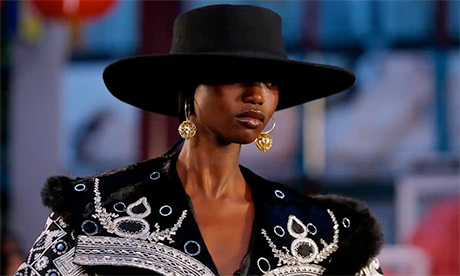Are Muslim women being asked to change too much of themselves in order to fit in?
‘Modest fashion’ has been a defining style for the past decade.
The trend for oversize silhouettes and loose layers has united fashion fans, religious and secular; it has been in part an attempt by western brands to buy into the lucrative market of Muslim consumers.
This shift has also seen the headscarf become increasingly acceptable, even covetable, in western fashion, with Nike, Uniqlo, Liberty, Tommy Hilfiger and Dolce & Gabbana among the brands selling scarves overtly tailored for use as hijabs in recent years.
Islamic dress, however, remains a lightning rod for controversy.
Hijab bans are continually discussed in France, while Switzerland is to hold a referendum on burqas this week, even as governments worldwide encourage the use of face masks.
China, too, has persecuted women for wearing the hijab.
In fashion, nothing has illustrated the tension as clearly as the story of Halima Aden, the trailblazing hijab-wearing Muslim model who was celebrated as an icon of inclusivity when she made her debut at Kanye West’s New York fashion week show in 2017, then walked for Alberta Ferretti and Maxmara in Milan.
Aden appeared on magazine covers, including British Vogue, and won major commercial contracts. Carine Roitfeld described her as “a different beauty”, saying she was “drawn to her instantly”.
Her inclusion was a win-win for the western fashion industry, which slapped itself on the back for doing a service to diversity while also attracting a profitable new audience.
But two months ago, Aden announced that she was quitting the fashion industry because she felt the work had compromised her religious beliefs – particularly those concerning the hijab.
The fashion industry – with its paucity of Muslim stylists – didn’t understand the hijab within a religious, rather than aesthetic, context.
In a series of emotional posts to her 1.4m followers on Instagram Stories, she showed a range of pictures of the way she was styled, with hats and various accessories used to meet the technical requirements of covering her hair (on one occasion, this included pairs of jeans) and said that she had felt deeply unhappy about them.
She contrasted these images with photographs wearing coverings she was comfortable in, covering her ears, neck, shoulders and chest.
“Looking back now, I did what I said I would never do,” she wrote, “which is compromise who I am in order to fit in.”
Aden’s high-profile declaration magnified deeper issues within the “modest fashion” concept and sent shock waves through the world of Muslim influencers and models, for whom she had become a kind of unofficial figurehead.
“Halima’s words caused a huge ripple in our community. Everyone was talking about it,” says influencer Sebina Hussain, an influencer also known online as Sebinaah, who works with brands including Viktor & Rolf and Swarovski.
“For as long as I can remember, the media has portrayed women in hijab as oppressed. That is until modest fashion came along and the conversation for some-part has shifted,” says Hussain.
This shift has, according to Hussain, left those adopting a less commercial look behind.
“I’ve experienced it first-hand, how differently people treat me when I go out in an Abaya and no makeup versus an outfit from the high street and a face full of makeup.”
In her work as an influencer, she has had to speak out when concepts do not align with her values. “Many times I’ve worried I am being a nuisance and the brand may not want to work with me again”.
Although so far, her clients have always taken her concerns on board, this ties into “a huge pressure on Muslim women to look more western in any situation.
The pressure is to want to appear more ‘normal’, to wipe away this negative stereotype associated with women in hijab,” she says.
Aden, too, said she felt this pressure.
In her case, as a 19-year-old newcomer to the fashion industry, she said she felt “too scared to speak up” on photoshoots.
She noted being called “frumpy” when opting for a more traditional hijab and said she felt pressure to look more “sexy”.
She asserted that the fashion industry – with its paucity of Muslim stylists – didn’t understand the hijab within a religious, rather than aesthetic, context. Continue reading
Additional readingNews category: Analysis and Comment.




